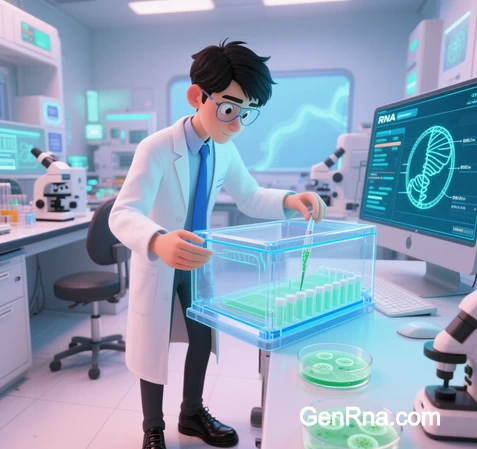 I. Foundational Principles of RNA Isolation
I. Foundational Principles of RNA Isolation
RNA extraction is the process of isolating intact RNA molecules while preserving structural integrity and eliminating contaminants. Key biochemical principles include:
- RNase Inactivation
- Endogenous ribonucleases degrade RNA within seconds of cell lysis. Guanidinium thiocyanate (a potent protein denaturant) irreversibly denatures RNases .
- Diethyl pyrocarbonate (DEPC) treats water/solutions to inhibit RNase activity .
- Phase Separation Chemistry
- Acidic phenol-chloroform mixtures separate RNA (aqueous phase), DNA (interphase), and proteins/organics (organic phase) based on solubility differences .
(Fig. 1: Phase separation schematic after cell lysis)
Description: Layered solution showing RNA in clear aqueous phase (top), DNA/protein at interphase, and phenol-chloroform (bottom).
- Acidic phenol-chloroform mixtures separate RNA (aqueous phase), DNA (interphase), and proteins/organics (organic phase) based on solubility differences .
II. Step-by-Step Extraction Protocol
A. Sample Preparation & Lysis
| Sample Type | Handling Protocol | Critical Parameters |
|---|---|---|
| Tissues | Snap-freeze in liquid N₂; homogenize in lysis buffer | Particle size <100µm |
| Cultured Cells | Direct lysis in TRIzol® or guanidinium buffer | Adherent cells scraped in situ |
| Whole Blood | Use PAXgene tubes with RNA stabilizers | Avoid hemolysis |
| Microbes | Lysozyme pretreatment + mechanical disruption | Remove polysaccharides |

B. RNA Purification
- Organic Extraction Method (Traditional):
- Add acid phenol-chloroform-isoamyl alcohol (25:24:1) to lysate
- Centrifuge at 12,000g for 15 min at 4°C
- Transfer aqueous phase to fresh tube
- Silica-Membrane Purification (Kit-Based):
- Bind RNA to silica columns in high-salt buffer
- Wash with ethanol-containing buffers
- Elute in RNase-free water
(Fig. 2: RNA binding to silica membrane under chaotropic conditions)
Description: Micrograph showing RNA (blue) adsorbed onto silica fibers in spin column.
C. DNA Elimination & Precipitation
- DNase I Treatment: Incubate 15 min at 37°C followed by inactivation
- Alcohol Precipitation:
- Add 0.1 vol sodium acetate (3M, pH 5.2) + 2.5 vol ice-cold ethanol
- Incubate at -80°C for 30 min
- Centrifuge at 12,000g for 20 min
III. Quality Control & Integrity Assessment
A. Spectrophotometric Analysis
| Parameter | Target Value | Interpretation |
|---|---|---|
| A260/A280 | 1.8–2.0 | High-purity RNA |
| A260/A230 | >2.0 | Low organic/inorganic contaminants |
| Concentration | >50 ng/µL | Adequate for downstream applications |
B. Electrophoretic Integrity
- Denaturing Agarose Gel:
- Distinct 28S and 18S ribosomal bands
- 28S:18S intensity ratio ~2:1 indicates intact RNA
- Bioanalyzer Profile:
- RNA Integrity Number (RIN) >7 required for RNA-seq
(Fig. 3: Bioanalyzer output showing intact RNA peaks vs. degraded samples)
Description: Electropherogram with sharp 28S/18S peaks (green) vs. degraded smear (red).
- RNA Integrity Number (RIN) >7 required for RNA-seq
IV. Specialized Extraction Challenges
A. Difficult Samples
| Sample Type | Solution | Reference |
|---|---|---|
| Plant Tissues | CTAB buffer to remove polyphenols | |
| Adipose Tissue | Extended chloroform washes | |
| Formalin-Fixed Samples | Proteinase K digestion at 56°C |
B. Low-Input Applications
- Carrier RNA Enhancement: Add 1 µg glycogen or linear acrylamide during precipitation
- Small RNA Recovery: Use silica columns with >700 µL binding capacity
V. Commercial Systems Compared
| Technology | Principle | Best For |
|---|---|---|
| TRIzol®/Chloroform | Phase separation | High-yield total RNA |
| RNeasy® (Qiagen) | Silica-membrane binding | Clinical/high-purity needs |
| Magnetic Beads | Paramagnetic particle binding | Automated high-throughput |
| CTAB-Phenol | Polysaccharide removal | Plants/fungi |
VI. Emerging Innovations
- Automated Liquid Handlers:
- Integrate lysis, purification, and QC in 45-minute workflows
- Single-Cell RNA Extraction:
- Microfluidics with picoliter-scale reaction chambers
- In Situ RNA Capture:
- Spatial transcriptomics using barcoded oligo-dT arrays
(Fig. 4: Microfluidic chip for single-cell RNA capture)
Description: Chip architecture showing cell lysis chambers and purification channels.
Conclusion: Precision in RNA Isolation
Effective RNA extraction requires:
- Speed: Process samples within 30 minutes of collection
- Temperature Control: Maintain 4°C during lysis/purification
- RNase-Free Environment: Use barrier tips, DEPC-treated solutions, and dedicated equipment
- Sample-Specific Optimization: Adapt protocols for blood, plants, or FFPE samples
“RNA extraction remains the cornerstone of molecular diagnostics – where rigorous attention to chemical principles separates actionable data from analytical artifacts.”
— Genomic Technology Review
Future advancements will focus on integrated systems that combine extraction, quantification, and library prep in closed microfluidic platforms.
Data sourced from publicly available references. For collaboration or domain acquisition inquiries, contact: chuanchuan810@gmail.com.
